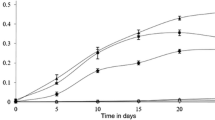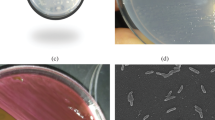Abstract
Crude oil-contaminated soil samples were gathered across Khuzestan oilfields (National Iranian South Oil Company, NISOC) consequently experienced a screening procedure for isolating C–S targeted dibenzothiophene-biodegrading microorganisms with previously optimized techniques. Among the isolates, a bacterial strain was selected due to its capability of biodegrading dibenzothiophene in a C–S targeted manner in aqueous phases and medium mostly consisting of separately biphasic water–gasoline. The 16S rDNA of the isolate was amplified using eubacterial-specific primers and then sequenced. Based on sequence data analysis, the microorganism, designated NISOC-04, clustered most closely with the members of the genus Stenotrophomonas. Gas chromatography indicated that Stenotrophomonas sp. NISOC-04 utilizes 82% of starting 0.8 mM dibenzothiophene within a 48-h-long exponential growth phase. Growth curve analysis revealed the inability of Stenotrophomonas sp. NISOC-04 to utilize dibenzothiophene (DBT) as the exclusive carbon or carbon/sulfur source. Gibbs’ assay showed no 2-hydroxy biphenyl accumulation, but HPLC confirmed the presence of 2-hydroxy biphenyl as the final product of DBT desulfurization. Under sulfur starvation, Stenotrophomonas sp. NISOC-04 produced a huge biomass with untraceable sulfur and utilized atmospheric insignificant sulfur levels.




Similar content being viewed by others
References
Ollivier, B., & Magot, M. (2005). Petroleum microbiology (pp. 239–252). USA: Blackwell.
Mohebali, G., Ball, A. S., Rasekh, B., & Kaytash, A. (2007). Biodesulfurization potential of a newly isolated bacterium, Gordonia alkanivorans RIPI90A. Enzyme and Microbial Technology, 40, 578–584. doi:10.1016/j.enzmictec.2006.05.012.
Garcia, C. I., Valencia, D., Klimova, T., Oviedo, R. R., Martınez, M. J. M., Balderas, R. G., et al. (2008). Proton affinity of S-containing aromatic compounds: Implications for crude oil hydrodesulfurization. Journal of Molecular Catalysis A Chemical, 281, 79–84.
Rashidi, L., Mohebali, G., Towfighi, Jd, & Rasekh, B. (2006). Biodesulfurization of dibenzothiophene and its alkylated derivatives through the sulfur-specific pathway by the bacterium RIPI-S81. African Journal of Biotechnology, 5, 351–356.
Rashtchi, M., Mohebali, G. H., Akbarnejad, M. M., Towfighi, J., Rasekh, B., & Keytash, A. (2006). Analysis of biodesulfurization of model oil system by the bacterium, strain RIPI-22. Biochemical Engineering Journal, 29, 169–173.
Furimskya, E., & Massoth, F. (1999). Deactivation of hydroprocessing catalysts. Catalysis Today, 52, 381–495.
Kirkwood, K. M., Andersson, J. T., Fedorak, P. M., Foght, J. M., & Gray, M. R. (2007). Sulfur from benzothiophene and alkylbenzothiophenes supports growth of Rhodococcus sp. strain JVH1. Biodegradation, 18, 541–549.
Kirkwood, K. M., Foght, J. M., & Gray, M. R. (2007). Selectivity among organic sulfur compounds in one- and two-liquid-phase cultures of Rhodococcus sp. strain JVH1. Biodegradation, 18, 473–480.
Chang, J. H., Chang, Y. K., Cho, K., & Chang, H. N. (2000). Desulfurization of model and diesel oils by resting cells of Gordona sp. Biotechnology Letters, 22, 193–196.
Chen, H., Wen-Juan, Z., Jian-Meng, C., Yu-Bei, C., & Wei, L. (2008). Desulfurization of various organic sulfur compounds and the mixture of DBT 4,6-DMDBT by Mycobacterium sp. ZD-19. Bioresource Technology, 99, 3630–3634.
Delolmo, C. H., Alcon, A., Santos, V. E., & Garcia, O. F. (2005). Modeling the production of a Rhodococcus erythropolis IGTS8 biocatalyst for DBT biodesulfurization: Influence of media composition. Enzyme and Microbial Technology, 37, 157–166.
Denome, S. A., Stanley, D. C., Olson, E. S., & Young, K. D. (1993). Metabolism of dibenzothiophene and naphthalene in Pseudomonas strains: complete DNA sequence of an upper naphthalene catabolic pathway. Journal of Bacteriology, 175, 6890–6901.
Duarte, G. F., Rosado, A. S., Seldin, L. De, Araujo, W., & Van Elsas, J. D. (2001). Analysis of bacterial community structure in sulfurous-oil-containing soils and detection of species carrying dibenzothiophene desulfurization (dsz) genes. Applied and Environmental Microbiology, 67, 1052–1062.
Luo, M. F., Xing, J. M., Gou, Z. X., Li, S., Liu, H. Z., & Chen, J. Y. (2003). Desulfurization of dibenzothiophene by lyophilized cells of Pseudomonas delafieldii R-8 in the presence of dodecane. Biochemical Engineering Journal, 13, 1–6.
Kirimura, K., Furuya, T., Nishii, Y., Ishii, Y., Kino, K., & Usami, S. (2001). Biodesulfurization of dibenzothiophene and its derivatives through the selective cleavage of carbon-sulfur bonds by a moderately thermophilic bacterium Bacillus subtilis Wu-S2b. Journal of Bioscience and Bioengineering, 91, 262–266.
Ting, M., Guoqiang, L., Jian, L., Fenglai, L., & Rulin, L. (2006). Desulfurization of dibenzothiophene by Bacillus subtilis recombinants carrying dszABC and dszD genes. Biotechnology Letters, 28, 1095–1100.
Fuli, L., Ping, U., Jinhui, F., Ling, M., Yuan, Z., Lailong, L., et al. (2003). Microbial desulfurization of gasoline in a Mycobacterium goodie X7B immobilized-cell system. Applied and Environmental Microbiology, 71, 276–281.
Jong, S. S., Young, S. K., Kyu, C., & Qing, X. L. (2006). Degradation of dibenzothiophene and carbazole by Arthrobacter sp. P1-1. International Biodeterioration and Biodegradation, 58, 36–43.
Kimiko, W., Noda, K., Konishi, J., & Maruhashi, K. (2003). Desulfurization of 2,4,6,8-tetraethyl dibenzothiophene by recombinant Mycobacterium sp. strain MR65. Biotechnology Letters, 25, 1451–1456.
Okada, H., Nobuhiko, N., Tadaatsu, N., & Kenji, M. (2002). Analyses of substrate specificity of the desulfurizing bacterium Mycobacterium sp. G3. Journal of Bioscience and Bioengineering, 93, 228–233.
Li, W., Ying, Z., Miao, D. W., & Yao, S. (2005). Biodesulfurization of dibenzothiophene and other organic sulfur compounds by a newly isolated Microbacterium strain ZD-M2. FEMS Microbiology Letters, 247, 45–50.
Papizadeh, M., Roayaei ardakani, M., Ebrahimipour, G., & Motamedi, H. (2010). Utilization of dibenzothiophene as sulfur source by Microbacterium sp. NISOC-06. World Journal of Microbiology and Biotechnology, 26, 1195–1200.
Lee, I., Hee-Sung, B., Wook, R. H., Kyung-Suk, C., & Chang, Yk. (2005). Biocatalytic desulfurization of diesel oil in an air-lift reactor with immobilized Gordonia nitida CYKS1 Cells. Biotechnology, 21, 781–785.
Alves, L., Salgueiro, R., Rodrigues, C., Mesquita, E., Matos, J., & Gírio, F. M. (2005). Desulfurization of dibenzothiophene, benzothiophene, and other thiophene analogs by a newly isolated bacterium, Gordonia alkanivorans strain 1B. Applied Biochemistry and Biotechnology, 120, 199–208.
Kilbane, J. J., Daram, A., Abbasian, J. C., & Kayser, K. J. (2002). Isolation and characterization of Sphingomonas sp. GTIN11 capable of carbazole metabolism in petroleum. Biochemical and Biophysical Research Communications, 297, 242–248.
Gray, K. A., Mrachkoyz, T. G., & Squires, C. H. (2003). Biodesulfurization of fossil fuels. Current Opinion in Microbiology, 6, 229–235.
Etemadifar, Z., Emtiazi, G., & Peimanfar, S. (2006). Removal of dibenzothiophene, biphenyl and phenol from waste by Trichosporon sp. African Journal of Biotechnology, 1, 72–76.
Caro, A., Boltes, K., Letón, P., & García-Calvo, E. (2008). Description of by-product inhibiton effects on biodesulfurization of dibenzothiophene in biphasic media. Biodegradation, 19, 599–611.
Van der Ploeg, J. R., & Leisinger, E. E. T. (2001). Sulfonate-sulfur metabolism and its regulation in Escherichia coli. Archives of Microbiology, 176, 1–8.
Seo, J. S., Keum, Y. S., Cho, I. K., & Li, Q. X. (2006). Degradation of dibenzothiophene and carbazole by Arthrobacter sp. P1-1. International Biodeterioration and Biodegradation, 58, 36–43.
Etemadifar, Z., Emtiazi, G., & Christofi, N. (2008). Enhanced desulfurization activity in protoplast transformed Rhodococcus erythropolis. American-Eurasian Journal of Agricultural & Environmental Sciences, 3, 285–291.
Acknowledgment
This work was supported by the Research vice Deputy, Shahid Chamran University of Ahvaz, and National Iranian South Oil Company (NISOC; R&D Department, the Department of chemicals, and the laboratorial complex). We warmly appreciate efforts made by Seyed Abbas Dibaj and Abdollah Ahmadiseresht, the expert staff of the Gas Chromatography (GC) Laboratory of NISOC. We are so grateful to Man Bock Gu and Ashok Mulchandani for managing the review process and Jamaledin Adel and the reviewers for their help in improving the content of this work.
Author information
Authors and Affiliations
Corresponding author
Rights and permissions
About this article
Cite this article
Papizadeh, M., Ardakani, M.R., Motamedi, H. et al. C–S Targeted Biodegradation of Dibenzothiophene by Stenotrophomonas sp. NISOC-04. Appl Biochem Biotechnol 165, 938–948 (2011). https://doi.org/10.1007/s12010-011-9310-3
Received:
Accepted:
Published:
Issue Date:
DOI: https://doi.org/10.1007/s12010-011-9310-3




